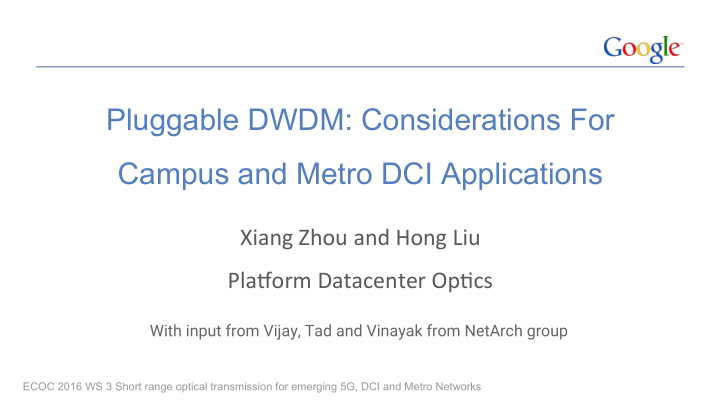



Pluggable DWDM: Considerations For Campus and Metro DCI Applications Xiang Zhou and Hong Liu Pla0orm Datacenter Op9cs With input from Vijay, Tad and Vinayak from NetArch group ECOC 2016 WS 3 Short range optical transmission for emerging 5G, DCI and Metro Networks
Google DC Interconnection Network Global Inter-DC Inter-DC DC to Backbone Intra-DC (Backbone, LH) (Campus) (Metro) (Clusters) 500m-1km 2km Distance 1000s km 80km m Cluster
Google Datacenter Traffic Growth ● Datacenter traffic has increased 50x from 2008 to 2014 ● Roughly doubling every year. ○ Faster than Internet growth
Datacenter Campus Network (today) Google’s Perspec9ve ● Interconnec9ng mul9ple DCs with geographic proximity ( ~ 2km) ● One or mul9ple warehouse computers (Clusters) within each DC ○ Google Jupiter cluster provides 1.3 Petabits bisec9on bandwidth ● Interconnec9on technique ○ Pluggable gray op9cs (typical) ○ Single mode fiber Google Oklahoma data center campus
Edge access (Metro) network (today) Lineside Client gray op9cs DWDM Transport based DWDM Backbone DWDM Datacenter Transport router Transport router ● Interconnec9ng datacenter/POP and backbone (~40 - 80km) ● Tradi9onal DWDM transport technique ○ Grey Op9cs for client side, colored DWDM op9cs for line side ○ Client side speed typically smaller than lineside speed
Challenges Facing Current Solutions q Bandwidth scaling challenge for DCI campus o Fiber exhaus9on problem § Pulling new fiber is expensive § Pulling new fiber also constrained by physical condi9ons q Cost scaling challenges for DCI Metro (edge access ) o Muxponder based DWDM op9mized for tradi9onal telecom Metro, where § reach up to 300-600km § client speed significantly slower than lineside speed o Not op9mal for DCI metro, where § reach only ~40 - 80km § client speed equal (or close) to the lineside speed
Emerging Technical Trend DWDM directly on Linecard Backbone Datacenter router router/Switch ● D WDM directly on router and switch card (pluggable DWDM) ○ Elimina9ng client interconnec9on and terminal chassis (reduce cost, power) ○ Allowing simpler management and control ○ Poten9al use for both campus and Metro
Pluggable DWDM: Performance Metrics Google’s Perspec9ve q Cost q Power, Size and Density o DC grey optics form factor q Wavelength Tunability q Link performance (OSNR, dispersion tolerance etc) q Spectral Efficiency (less important than LH)
100G Tunable QSFP28: Enabling Technologies q Serial 100Gb/s direct modulation with 16nm CMOS o 50-Gbaud PAM4 [1] o 50-Gbaud (equivalent) DMT PAM4 q Lower power and small footprint tunable lase o With relaxed power,wavelength stability and phase noise requirements q FBG based full C-band tunable DCM (in line systems) [1] over 80km performance demonstrated: D. Sadot et al, OE 2015 DMT ( courtesy to Socionext )
Revisit Optical Dispersion Compensation q Multi-span DWDM systems o Require optical DCM every span o Additional tunable DCM o Cost is high compared to electrical dispersion compensator q Single-span DCI Metro o Single broadband tunable DCM (FBG based technology) Broadband TDCM o Cost and power shared by 40-80 channels § Likely lower than electrical dispersion compensator o Reduce transceiver power § Help meet stringent power density requirement of pluggable optics
Beyond 100G: Coherent or Direct Detection ? q Direct detection o Require multiple tunable lasers (four for 400G ! ) § Cost and power likely high o Spectral efficiency (SE) difficult to scale § Single sideband modulation could double SE but complex Tx design q Coherent detection o Single tunable laser for 400G (shared by both the signal and the LO !) § More stringent laser performance o Higher spectral efficiency (2-4 times higher) o Support greater link loss (better OSNR sensitivity) o High DSP power: extra power for pol. and phase recovery
Ultra-Low Power Coherent DSP q 7nm CMOS node With Baud-rate DSP q Baud-rate or minimum over-sampling DSP o Baud-rate DSP achieves the lowest power consump9on but has limited dispersion compensa9on capability q Minimal MIMO EQ tap length q Less powerful FEC q 2/3-bit DAC for 16/64-QAM Residual CD (ps/nm) q Remove OTN framer
Conclusions q Grey op9cs DC campus interconnec9on faces bandwidth scaling challenges q Pluggable (and tunable) DWDM is a promising solu9on for both campus and Metro without sacrifice of router and switch port density q PAM4/DMT based serial 100G could enable 100G tunable QSFP28 q 7nm ultra-low power coherent DSP likely enables 400G pluggable DWDM
Recommend
More recommend